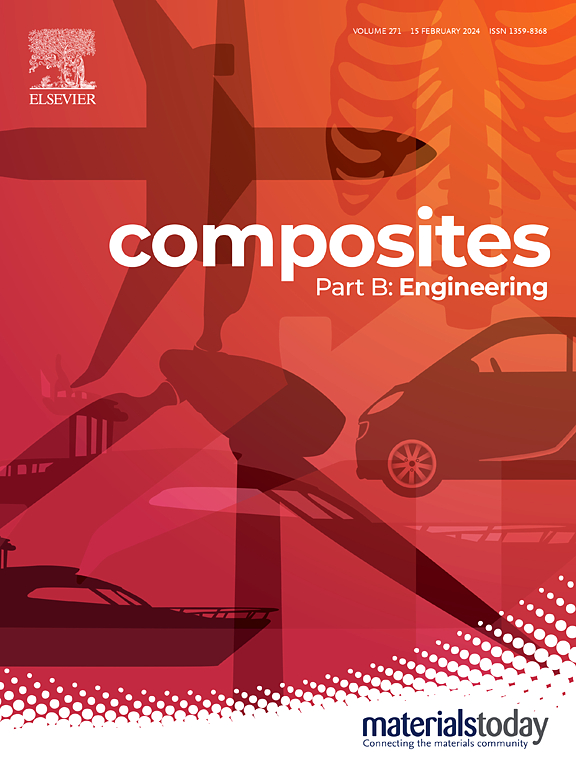Enhancing mechanical properties of 2D carbon/carbon composites via ZIF-67@CNTs-modified interfacial Layers: Mechanisms and performance optimization
IF 14.2
1区 材料科学
Q1 ENGINEERING, MULTIDISCIPLINARY
引用次数: 0
Abstract
The interfacial bonding condition significantly governs the mechanical properties and performance of carbon/carbon (C/C) composites. This study presents a novel approach for constructing an interfacial layer modified by carbon nanotubes (CNTs) on the surface of carbon fibers (CFs), utilizing cobalt 2-methylimidazole (ZIF-67) as a catalyst precursor. Subsequently, the morphology of the interfacial layer within the cloth-laminated C/C composites was characterized, and the macroscopic and microscopic mechanical properties of CNTs-modified C/C (CNTs-C/C) composites were investigated. The out-of-plane compressive strength (OCS) and the interlaminar shear strength (ILSS) of the CNTs-C/C composites increased to 380 ± 19 MPa and 30.96 ± 1.43 MPa, respectively. These values represent remarkable increases of 85.4 % and 91.2 % compared to the C/C composites. The nanoindentation and fiber push-in tests revealed substantial improvements in both the interfacial layer strength and interfacial shear strength (IFSS) of the CNTs-C/C composites. The reinforced interfacial layer not only enhances crack propagation resistance but also strengthens the fiber-matrix bonding, thereby promoting CFs pull-out behavior. Furthermore, the high-strength interfacial layer exhibits enhanced load transfer efficiency to the CFs, thereby improve the overall load-bearing capacity of the composites. Consequently, the CNTs-C/C composites demonstrate superior comprehensive mechanical properties, achieving a flexural strength of 315 ± 14 MPa, representing a 57.5 % enhancement compared to the C/C composites.

通过ZIF-67@CNTs-modified界面层增强二维碳/碳复合材料的力学性能:机制和性能优化
界面结合条件对碳/碳(C/C)复合材料的力学性能和性能有重要影响。本研究提出了一种利用2-甲基咪唑钴(ZIF-67)作为催化剂前驱体,在碳纤维表面构建碳纳米管修饰界面层的新方法。随后,表征了布层C/C复合材料内部界面层的形貌,并研究了碳纳米管改性C/C (CNTs-C/C)复合材料的宏观和微观力学性能。CNTs-C/C复合材料的面外抗压强度(OCS)和层间抗剪强度(ILSS)分别提高到380±19 MPa和30.96±1.43 MPa。与C/C复合材料相比,这些值分别显著增加了85.4%和91.2%。纳米压痕和纤维推入试验表明,CNTs-C/C复合材料的界面层强度和界面剪切强度(IFSS)均有显著提高。增强的界面层不仅增强了抗裂纹扩展能力,而且增强了纤维与基体的结合,从而促进了碳纤维的拉拔行为。此外,高强度界面层增强了载荷向碳纤维的传递效率,从而提高了复合材料的整体承载能力。因此,CNTs-C/C复合材料表现出优异的综合机械性能,达到315±14 MPa的抗弯强度,与C/C复合材料相比提高了57.5%。
本文章由计算机程序翻译,如有差异,请以英文原文为准。
求助全文
约1分钟内获得全文
求助全文
来源期刊

Composites Part B: Engineering
工程技术-材料科学:复合
CiteScore
24.40
自引率
11.50%
发文量
784
审稿时长
21 days
期刊介绍:
Composites Part B: Engineering is a journal that publishes impactful research of high quality on composite materials. This research is supported by fundamental mechanics and materials science and engineering approaches. The targeted research can cover a wide range of length scales, ranging from nano to micro and meso, and even to the full product and structure level. The journal specifically focuses on engineering applications that involve high performance composites. These applications can range from low volume and high cost to high volume and low cost composite development.
The main goal of the journal is to provide a platform for the prompt publication of original and high quality research. The emphasis is on design, development, modeling, validation, and manufacturing of engineering details and concepts. The journal welcomes both basic research papers and proposals for review articles. Authors are encouraged to address challenges across various application areas. These areas include, but are not limited to, aerospace, automotive, and other surface transportation. The journal also covers energy-related applications, with a focus on renewable energy. Other application areas include infrastructure, off-shore and maritime projects, health care technology, and recreational products.
 求助内容:
求助内容: 应助结果提醒方式:
应助结果提醒方式:


